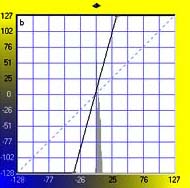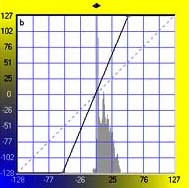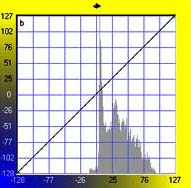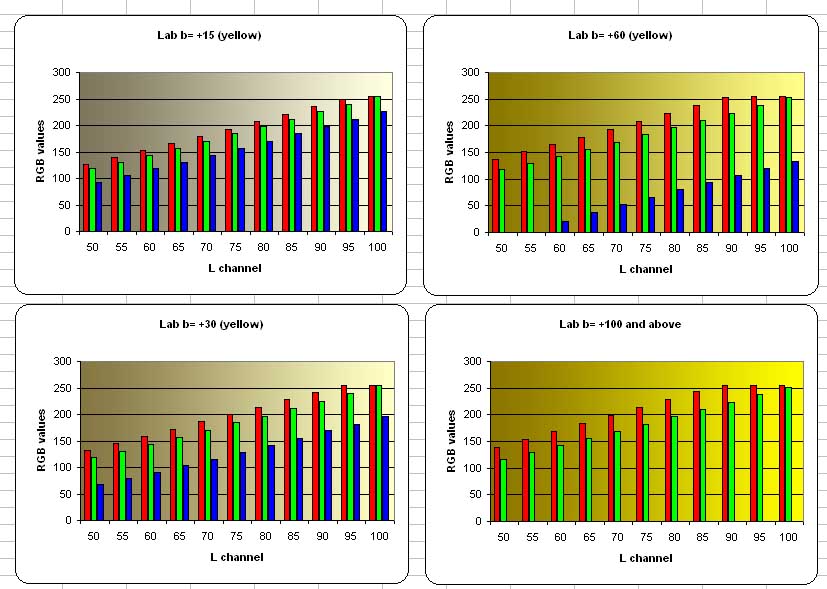
Impossible Lab Colours
Lets look at how and why Lab can produce impossible colours that are useful in our colour phase of the work flow. Which impossible colour shall I show you - ha ha! Lets play with some Yellows.
I think that two things come into play.
First there is the fact that when we expand the range of values in a histogram, a bunched up block expands to use more values/space. So starting with an image that has the b channels histogram (below left), each time we expand it (shown by the straight curve), more and more intense yellow is added.
 |
 |
 |
We started with a range of 0 to 10 and ended up with a range from 0 to 100. During this expansion there may be holes left, i.e. some values not present, in the range, although this doesn't seem to effect how we perceive the overall colours. The CurveMeister histogram above does not show missing values, but Photoshop will - try expanding a dull image using Levels (in RGB) and then pop-up another histogram to see what I mean.
Secondly there is the problem of how Photoshop (or any other colour aware program) converts from one colour space to another. If there is not an exact 1:1 match, then the colour is out of gamut, in the converted colour mode, and so the nearest colour is chosen, changing lightness, colourfulness, and sometimes hue in the process. You may be familiar with this if you have used a Proofing window (WIndow>Documents>New Window and set View>Proof Colors and perhaps View>Gamut Warning) open when viewing an image.
The following four histogram show plots of different b channel values, each with varying L channel values compared to how Photoshop converted them into sRGB values. I have painted a gradient behind them to show the sRGB equivalent colours - obviously impossible to show the Lab ones as we move into the impossible space!

The first two left histograms show that the RGB values march in step, until we get to L=100 where Red 255 is not enough. It never occurred to me, when I thought to try this idea, that there was Blue in Yellow, but it is there because the RGB space has both colour and lightness in their channel values. If you use other RGB colour spaces, you will naturally get different results.
If we look at the two histograms on the right, which are really beginning to push the b channel value up (60 and 100), sRGB Red begins to be clipped earlier and also, as the b channel value increase (more intense Yellow), the sRGB Blue channel disappears. So we actually wind up with a darker yellow in the sRGB space, as we have lost the lightness input from the Blue channel completely. This is counter-intuitive as one would have thought that the more intense the colour and the more powerful/lighter it is, then the brighter it would actually be.
Worse than that is the next histogram, which I'm not going to bother to show you, when the b channel is at +127 (maximum Yellow) - it is exactly the same as the b=+100 histogram!! Thus we have really gone out of gamut when the Lab value is barely 75% of it's maximum.
So merging these two aspects, we can see for +ve b channel values, and obviously this applies to the a channel and also -ve values (but in a different way), strange things happen (during the conversion back to sRGB, or to the screen) when the values get large. When we play with curves in Lab colour, we are pushing the colour to more intense values and getting some lovely effects.
The Blown HighLight technique takes advantage of Photoshop's compromise in dealing with an imaginary colour when converting from Lab to RGB. In any specular or blown-out highlight in RGB, the white area inherently must be neutral, R=G=B. But in Lab when that area's luminosity L is 100, it nevertheless still can have non-neutral, even fully-saturated colour values in the colour ab channels. Consequently, Photoshop reconciles the increasing impossibility of a non-neutral highlight as it approaches a specular by "splitting the difference" when converting to RGB. The crux of the procedure, allowing the Color blending mode to merge when doing the Lab>RGB conversion, harnesses this effect to nicely fix blown-out highlights, whereas the same blending mode would have failed if done in RGB.
One should perhaps mention that some lab colours are beyond our ability to perceive them and can not exist in the physical world, like a very dark brilliant yellow - however this is a feature of lab that need not concern us when we use of it.
If you want to play and see all the Lab colours, then download and run this Action (if you do not know about Actions, then see instructions in this page).